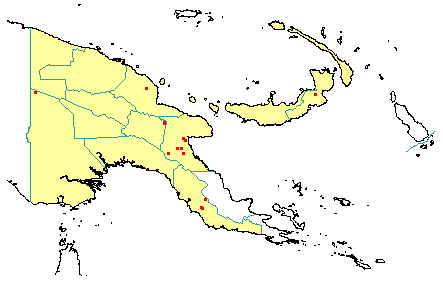
in PNGplants database
PNGTreesKey – Magnolia tsiampacca (L.) Figlar & Noot. subsp. tsiampacca |
Barry Conn (NSW) & Kipiro Damas (LAE).
Guide to trees of Papua New Guinea
Copyright held by the authors, National Herbarium of New South Wales, and Papua New Guinea National Herbarium
in Praglowski, World Pollen and Spore Flora Vol. 3: 5 (1974)
Other Literature: J.R. Croft, Handbooks of the Flora of Papua New Guinea 130-132 (1978) Fig. 65 (asElmerrillia papuana).
Family: Magnoliaceae
Dicotyledon
Timber Group: Major exportable hardwood
Field Characters: Emergent tree (up to 60 m high) or Large canopy tree; Bole cylindrical (100-150 cm diam.); crooked or straight (bole 14-20 m long); buttresses buttresses present (occasionally buttresses up to 0.5 m high) or buttresses absent; spines spines absent; aerial roots aerial roots absent; stilt roots stilt roots absent; Bark green (sometimes blotches), grey, or brown (blotches), rough or slightly smooth, scaly or flaky (peeling in large irregular flakes) and pustular, lenticels elongated vertically; Subrhytidome (under-bark) orange (sometimes), green, and brown (with (blotches); less than 25 mm thick, (5.0-) 8.0-12.0; bark blaze consisting of one layer; strongly aromatic; spice-like; outer blaze white, yellow (pale (straw-coloured), and brown (pale (sometimes), markings absent, fibrous and granular without splinters; inner blaze white, yellow (pale (straw-coloured), and brown (pale (sometimes), markings absent, fibrous and granular without splinters; bark exudate (sap) absent; terminal buds not enclosed by leaves.
Indumentum: Complex hairs absent; stinging hairs absent; mature twig indumentum (hairs) present and absent, hairs dense to sparse.
Leaves: Leaves spaced along branches, spiral (leaves occurring singly at a node and arranged spirally up the branchlet), simple (a leaf composed of a single blade); petiole present, not winged, attached to base of leaf blade, not swollen or slightly swollen; leaves broadest above middle, rarely broadest at or near middle, or broadest below middle, 8.0-31.0 cm, 3.0-12.0 cm; rarely very asymmetric or symmetric, entire, not dissected or lobed, acute, acuminate, or long-tapering, venation pinnate, secondary veins open, prominent, intramarginal veins absent; leaves lower surface blue-green (slightly purplish-grey) or pale green (slightly silvery green), upper surface dark green, indumentum (hairs) present, indumentum (hairs) dense; absent; domatia absent; stipules present, free, laterally placed, encircling the twig, leafy, not fringed, large, not persistent.
Flowers: Inflorescence axillary, flowers single (sometimes in pairs), cones absent; flowers bisexual, stalked, flowers with many planes of symmetry, 15.0-20.0 mm long, diameter large (more than10 mm diam.); perianth present, with all sepals and/or petals (hence tepals) similar, inner perianth white; 12-18, free; stamens 25-30, present, free of each other, free of the perianth; ovary superior, carpels separate (when more than one), locules 1; styles free, 100.
Fruits: Infrutescence single, fruit 40.0-100.0 mm long, green, not spiny, non-fleshy, aggregate (consisting of free carpels spirally arranged around the receptacle), dehiscent, follicle (split on ventral side); seeds 100 (red or orange), to about 5 mm long, not winged, broad (as wide as long), seed 1-10 mm diam.
Distribution: West Sepik, East Sepik, Madang, Morobe, Western Highlands, Eastern Highlands, Southern Highlands, Western, Gulf, Central, New Britain & New Ireland.
 | Botanical records in PNGplants database |
Notes: Notes This species is divided into two varieties, namely, var. tsiampacca (which is variously hairy) and var. glaberrima (which is completely grlabrous). Previously, the plants included in this taxon were referred to as Elmerrillia papuana (Schltr) Dandy.